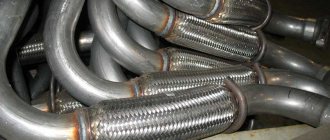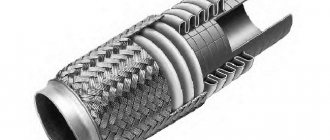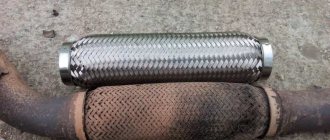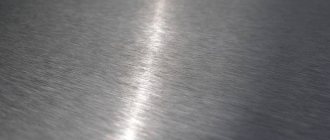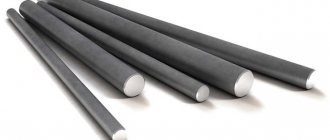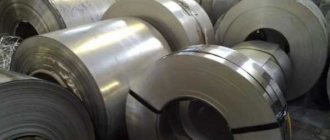Aluminized muffler.
Silencers are made from:
-Brown steel - service life 1-2 years
-Aluminized steel - service life 3-7 years (aluminization thickness is 25-50-75-100-125-150)
-Stainless steel - service life 10-15 years (steel grade 201-204-301-304-316)
The main products of our company are exhaust system parts - mufflers - resonators - pipes - downpipes - flame arresters - which are distinguished by high quality workmanship and a long service life. Our sales offer includes about 3,600 types of mufflers for cars of world brands. Thanks to the many years of existence of our Brand, we are among the largest manufacturers of mufflers and exhaust systems in Europe.
To cope with the entire spectrum of sound frequencies, several types of mufflers are used depending on the muffling methods. They are separated by location - in such cases, the resonator is sometimes called a preliminary or front muffler, and the absorption type muffler is called the main or rear muffler - or they are combined in one housing. If you add intermediate pipes and a bellows to the mentioned elements, popularly - a corrugation, which is a flexible connection that is necessary.
Article source: https://www.xn—-etbeccobtcc5eel4e4d.xn--p1ai/11-ssylki/7691-ssylka-9.html
Inconel
Known as a “super alloy,” Inconel is primarily made from nickel and chromium. Its strength is very high. Due to its high melting point, Inconel has become a popular alloy in the aerospace industry. It is also often used in nuclear reactor cores.
Did you know that for many years, Formula 1 car exhaust systems were made from Inconel 625? Thanks to this alloy, Formula 1 car designers were able to create thin exhaust systems for racing cars.
Consequently, this allowed for lightweight exhaust systems, which was very important for the final weight of the car. Including exhaust systems made of Inconel alloy, which are ideal for racing cars due to their high heat resistance.
As you might have guessed, since this material is used in the aerospace industry and in Formula 1 cars, we are talking about a very expensive alloy. Yes it is. Exhaust systems made from this alloy cost a lot of money. And not only because this material itself is very expensive, but also because it is very difficult to make a full-fledged exhaust system from this alloy. No, you can work with it and make complex configurations of exhaust systems, but the process itself is very labor-intensive.
It is not surprising that cars equipped with Inconel exhaust systems tend to be classified as exotic cars. For example, a similar system is installed on the Ferrari 488 Pista sports car.
There are a number of manufacturers in the world that produce exhaust systems from this superalloy for many sports cars. For example, Kline produces exhaust systems made from Inconel-625 alloy for the Lamborghini Gallardo. The only downside to this supercar exhaust kit is the cost. They cost about 750,000 rubles.
How to choose a car muffler
A car muffler refers to either the entire exhaust system as a whole, or only the rear part of it. This article is dedicated specifically to the rear part of the exhaust system. Of course, there are cars where the main muffler is located in the center of the exhaust tract, but we will discuss these cases separately.
A muffler is a part of a car's exhaust system that absorbs car noise. The higher the quality of this part, the lower the sound. The question immediately arises, which muffler is better and which is not? If you want to know the answer, read on.
Summary
The popularity of Euroformat aluminum hatches and the reliability of steel Format and Atlant models do not give a clear answer to the question of which hatch is better, aluminum or steel.
Aluminum hatches in Practice are not inferior in reliability to steel ones; steel ones gain in price, but lose in manufacturability. The manufacturer provides a 5-year warranty on all tile hatches. Competitors copy both, trying to keep up with the leader. The World of Hatches company recommends hatches for Praktika tiles - Euroformat, Format and Atlant. All articles in the “Useful Tips” series
Source
What is the difference between car mufflers
There are dozens of types of mufflers on the Russian auto parts market. European, Russian, Chinese, Turkish - how can a consumer choose a high-quality car muffler? Some are more expensive, others are cheaper. Some are painted, others are not. The brand of some is known to everyone, while the name of others means nothing. We are not going to advertise a specific brand, we are just going to help you make the right choice.
The main criterion for the quality of an exhaust system is the metal from which it is made.
Car mufflers are made from the following materials:
Most mufflers for foreign cars are made of aluminized steel. This material is more resistant to corrosion than regular steel, although the cost of an aluminized muffler is not much higher than that of steel. It is for this reason that Europe has completely stopped producing conventional steel mufflers. In Russia, mufflers made of black steel are still produced to this day.
Parts made of ordinary steel last no more than a year, while high-quality aluminized mufflers can be used for 4 to 6 years. Note the “quality” ones. Unfortunately, there are some that are not of good quality. Their service life does not exceed one year.
The problem is that it is impossible to assess the quality of an aluminized muffler by eye. But it can be easily distinguished from a muffler made of “black” steel. Parts made of black steel are usually painted silver, while unpainted parts are black. Mufflers are painted only to prevent them from rusting before sale. This is where the useful properties of painting end.
The aluminized steel muffler has an even white tint, like aluminum. There are also mufflers made of zinc and aluminum alloy. Their color is similar to ordinary galvanized roofs.
Stainless steel exhaust system parts are rarely found on the market. As a rule, these are original spare parts from well-known manufacturers. This is due to the fact that the price of stainless steel is significantly higher, and car enthusiasts do not want to pay this difference in money. Some car owners do not plan to drive their car for more than 2-3 years, others will prefer to replace the muffler after the same 3 years. It is for these reasons that stainless steel mufflers are not produced in large quantities.
Another important aspect of the quality of a muffler is its internal filling. It is only in appearance that mufflers from different manufacturers are similar in appearance. Exhaust sound absorption depends on several factors:
— presence of a two-layer casing;
— quality of internal perforated pipes;
— volume of the internal cavity of the muffler;
— heat resistance of the sound-absorbing padding and its resistance to blowing.
The cost of a muffler is directly proportional to its volume. One option to reduce the price is to simplify the design. Many unscrupulous manufacturers choose this path, which negatively affects the muffler’s ability to process the flow of exhaust gases. Reducing the volume of the can and simplifying the internal structure leads to a louder exhaust sound. And the use of low-quality acoustic filler leads to a rapid loss of its sound-absorbing properties. As a result, a “drum” effect appears.
Roar, shooting, condensation and other reasons to look under the car
It's easy to spot muffler problems. It is difficult not to notice extraneous sounds coming from under the car, or a sharp change in the tone and volume of the response to pressing the gas. It is not uncommon to notice fluid leaking or even splashing from the exhaust pipe. All these are signs of malfunctions, but do they all indicate problems in the exhaust system?
Fluid in the muffler
Fluid dripping from the exhaust pipe is a common occurrence. However, it is worth distinguishing what kind of liquid it is. If it's water, there's nothing wrong with it. When the ambient temperature changes, moisture from the air condenses on the surfaces of the muffler. If a steel muffler is used, this can lead to corrosion, but usually the Priora exhaust system uses aluminized steel or stainless steel, which means that damage from water will be minimal. In cases of heavy accumulation of water, experienced motorists usually drill a drainage hole in the “barrel” of the muffler.
If there is excessive accumulation of water in the muffler, in winter you may encounter icing of the exhaust pipe
If antifreeze drips from the exhaust pipe, the fault should be looked for not in the muffler, but in the engine. The reason may be wear of the cylinder head gasket, as well as depressurization of the block itself. Antifreeze in the exhaust pipe is a symptom of serious problems, and if it is detected, you should immediately diagnose the engine.
Pops and shots from the exhaust pipe
Popping noises coming from the muffler indicate a malfunction. However, this is also a malfunction of the engine, not the exhaust system. Shots or pops from the exhaust pipe indicate that the mixture of air and gasoline does not burn out in the cylinder block, which means that when you hear them, you should check the spark plugs and spark plug wires, as well as the serviceability of the gas distribution mechanism. Problems with combustion of the mixture are not a symptom of a muffler failure, but they can be its cause.
Article on the topic: Brake pad repair: when is it needed?
Video: this is what pops from the muffler sound like
Knocking from under the car
A knocking sound from under the bottom of the car while driving or rattling from vibrations is an unpleasant phenomenon. The muffler may touch the gas tank or the underbody. There are several possible reasons for this.
- First of all, check the rubber muffler hangers. Their wear leads to loosening of the entire exhaust system. These mounts are sold at most auto parts stores. Their price usually does not exceed 100 rubles per piece. Replace the suspension with new ones and the knocking will stop.
- It is worth checking whether the clamp connecting the main muffler and the additional muffler is loose. If necessary, replace the fastening bolts and nuts. For replacement, it is best to use fasteners made of heat-resistant materials.
- Using the wrong model of muffler with pipe bends that differ from the original spare part can lead to contact between the exhaust pipe and various components of the car: the body, the gas tank and even the suspension. Be careful when choosing a muffler.
Buying a high-quality car muffler is not easy, but we still have some tips
Rule one. You should not buy parts from dubious places. It is better to buy a car muffler where it can be installed on a car. In this case, you do not risk purchasing a spare part that will be louder than expected. Therefore, you will be able to return or exchange the part for a quality one.
Rule two. Find out which company made this part. To do this, you need to ask the seller for a certificate containing this information. It is necessary to take into account the fact that the well-known manufacturer has factories in China and Turkey. The quality of mufflers produced in these countries leaves much to be desired. But when buying products from unknown companies, the chance of getting a piece of iron is even higher.
The quality of a muffler can be assessed by the following criteria:
— appearance – the muffler should be similar in size and shape to the original;
— weight – the heavier the muffler, the better;
- build quality - there should be no folds on the welds;
— the presence of a manufacturer’s stamp - the part should not have a glued tag, but a logo pressed out with a press.
You should not buy a muffler that is painted silver, deformed or chipped. And, of course, you shouldn’t buy a cheap muffler. As a rule, such parts are not suitable for use at all.
Source of the article: https://avtovody.ru/advices/12-kak-vybrat-avtomobilnyi-glushitel.html
How to choose a quality muffler
A car muffler is a whole system consisting of three parts (main muffler, resonator and exhaust pipe). The complete definition of a muffler is an exhaust gas exhaust system. This system is an important functional part of the car and performs an irreplaceable job. Its main function is to reduce the noise level of exhaust gases, lower the temperature, and also reduce their harmful impact on the environment.
The domestic market includes dozens of exhaust system manufacturers. And sometimes it’s not easy to decide which product to choose. For a professional it is not difficult to assess the quality of a muffler, but for an ordinary person this is somewhat of a problem. After all, you will still have to pay to replace the muffler at a car service center. You can find out the price for replacing the muffler corrugation from our specialists.
It is important not to make a mistake and make the right choice among the wide range available on the market. Here you can find both expensive and cheap mufflers, made by well-known companies and completely unknown companies, with a certain design, and simple-looking ones. The optimal solution is, of course, to find the ideal combination of high quality and reasonable price.
Material from which the muffler is made
The steel from which the muffler is made is the most important indicator of its quality. Therefore, all mufflers that are produced on the domestic market are divided into several types, depending on their material. Here are the main types of metal used in the production of exhaust systems:
- simple “black” steel;
- stainless steel;
- aluminized steel.
Products made from simple, ordinary steel are considered cheap and low-grade. Mufflers made of this metal are usually painted silver, while unpainted ones are black. Paint does not play any role here and is only needed to ensure that the products take on a more or less marketable appearance and do not rust until the time of sale. This is where the useful properties of painting end. Such “black” mufflers only last from 6 months to a year, which is why they occupy the lowest niche both in price and quality.
Why is the steel used in the iPhone XS case better than aluminum?
When choosing metal products - heated towel rails and railings, dishes and fences, grates or handrails - we choose, first of all, the material. Traditionally, stainless steel, aluminum and regular black steel (carbon) are considered to compete. Although they have a number of similar characteristics, they nevertheless differ significantly from each other. It makes sense to compare them and figure out which is better: aluminum or stainless steel (black steel, due to its low corrosion resistance, will not be considered).
Advice for buyers on choosing a muffler
Of course, finding a car muffler of both high quality and at an affordable price is quite difficult, but following the recommendations described below is quite possible.
Firstly, you need to immediately see what metal the muffler is made of. This, of course, must be aluminized steel, and of very good quality.
Secondly, you need to buy an exhaust system only from well-known, trusted brands.
Next, you need to ask the seller for a certificate that contains information about the manufacturer of this part.
It is critical to examine the appearance of the muffler, which should be similar in size and shape to the original.
Pay attention to the weight of the system (it should not be light).
Evaluate the build quality. Make sure that there are no folds on the welds, which often occur when using manual welding.
Pay special attention to the presence of the manufacturer's stamp on the product. There should be not just a piece of paper glued to it, but a company logo, production date and Rosstandart sign pressed out with a press.
And of course, the most important thing. A self-respecting, serious manufacturer who is responsible for the quality of its muffler must provide a guarantee on it.
Following just these simple tips will allow you not only to please yourself with the purchase of a high-quality muffler, but also to avoid the risk of “throwing money down the drain” by buying a piece of iron that will “rumble” and will not last more than a year.
Recommendations
- ""Aluminized steel offers attractive physical characteristics for use in industrial duct construction." National Association of Sheet Metal and Air Conditioning Contractors. Retrieved February 26, 2011." Archived from the original on 2011-02-20. Retrieved 2011-02-26.
- Ki-Hyun, Kim. Van Daele, Benny. Van-Tendeloo, Goosfaaf. and Jung-Kyu, Yoon. (2006). "Observations on the formation of intermetallic compounds in hot aluminized steel". Materials Science Forum, 519-21(2), 1871-75.
- Atlas Steel - Aluminized steel
- "Archival copy." Archived from the original on 09/30/2010. Retrieved 2011-11-29.CS1 maint: zipped copy as title (link)
- Rajendran, R. Venkataswamy, S. Jaikrishna, U. Gowrishankar, N. and Rajadurai, A. (2006). "Influence of Process Parameters in Hot Aluminizing of Medium Carbon Steel".
- Deqing, Wang. and Ziyuan, Shi. (2003) “Formation of an Al2O3 layer on steel.” Journal of Materials Science, 22(14), 1003-1006.
- ^ a b
Wang, Chaur. Jeng. Badaruddin, Mohd.. (2010) "Dependence of high temperature resistance of aluminized steel subjected to steam-water oxidation." Surfaces and Coatings Technology, 205(5), 1200-1205.
Aluminum-silicon and aluminum-zinc pipes
Pipes for the production of mufflers.
The cold days are behind us, and spring is gaining momentum and many motorists who put their cars in the garage in the first days of winter are beginning to prepare them for active driving on our roads. Many people inspect their cars on their own, and some take them to a car service center for inspection. As a result of such an inspection, it may turn out that some part or spare part has become unusable and should be replaced. Among such spare parts there may be a car muffler. A car muffler is one of the important components that serves to reduce the noise of exhaust gases, reduce temperatures and convert the energy of exhaust gases. It is very important what material the muffler is made of, which primarily affects its burnout rate. Most often, muffler elements are made of carbon or aluminized steel, as well as stainless steel. Mufflers made of stainless steel are not very popular, since they take longer to manufacture than usual and their cost is several times higher than mufflers made of carbon and aluminized steel. The approximate term of service is from 10 to 15 years.
In the production of mufflers, high quality carbon steel is used, steel grades 08ps and 08yu, metal thickness can vary from 1.2 to 1.5 mm. The service life of such mufflers is 6 months. up to 2 years. In order to provide greater strength and wear resistance, the automotive industry has recently begun to increasingly use aluminized steel. The service life of such mufflers can be from 3 to 6 years. Aluminized steel comes in two types: aluminum-zinc and aluminum-silicon.
A lot of incandescent lamps are also used in production.
Aluminum zinc is thin-sheet galvanized cold-rolled steel. The zinc layer ensures the reliability of galvanized steel. Galvanized steel has a smooth, glossy silver surface. One of the most important factors in the use of this metal is its high degree of corrosion resistance. The protective coating of aluminum zinc consists of pseudo-alloys - aluminum (55%), zinc (43.4%) and silicon (1.6%). Thanks to the interaction of these elements, a balance between the corrosion resistance quality of aluminum and the protective galvanic properties of zinc is ensured. Aluminum forms the most stable oxide on the surface of a metal sheet and an intermetallic compound with silicon, which has a high degree of corrosion resistance, facilitating stronger adhesion of the coating to the base. All of the above provides reliable barrier protection for the penetration of the oxidizing environment deep into the metal. Zinc takes on the function of protecting the steel base from corrosion during the process of cutting metal or the occurrence of deep scratches on the surface of the protective layer. This happens because the electrochemical potential of zinc is much higher than iron; under the influence of electrochemical processes, zinc gradually begins to “dissolve,” freeing the steel sheet from the oxidized films that have arisen. This principle of protection is called “sacrificial protection”. Thanks to the “dissolution” of zinc, a thin oxide film remains, thanks to which corrosion does not penetrate the metal for quite a long time.
Aluminum-silicon is an electric-welded pipe with a double-sided aluminum-silicon coating, intended for the production of car muffler parts. The pipes are made of low carbon steel with a double-sided aluminized coating applied by hot method. The coating is based on an aluminum-based alloy with a silicon content of 5-11%. The thickness of the aluminum-silicon coating on each side is from 25 to 30 microns. To test the aluminum-silicon coating, the pipes are tested for corrosion resistance in neutral salt fog for 500 hours, tested in exhaust gas condensate, tested for heat resistance at a temperature of 615⁰C without the formation of swelling and peeling. Pipes with aluminum-silicon coating have a very high degree of corrosion resistance in aggressive environments and increased resistance to temperature influences. Pipes with aluminum-zinc and aluminum-silicon coatings are made of cold-rolled steel grade 08ps with a metal thickness of 1.5 mm.
Corrosive properties
Today, the only reliable source on the corrosion resistance of a particular sub-cladding structure, and, accordingly, durability, is the expert opinion of ExpertKorr-MISiS.
The most durable structures are made of stainless steel. The service life of such systems is at least 40 years in an urban industrial atmosphere of medium aggressiveness, and at least 50 years in a conditionally clean atmosphere of low aggressiveness.
Aluminum alloys, thanks to the oxide film, have high corrosion resistance, but under conditions of high levels of chlorides and sulfur in the atmosphere, rapidly developing intergranular corrosion can occur, which leads to a significant decrease in the strength of structural elements and their destruction. Thus, the service life of a structure made of aluminum alloys in an urban industrial atmosphere of average aggressiveness does not exceed 15 years. However, according to the requirements of Rosstroy, in the case of using aluminum alloys for the manufacture of elements of the substructure of an NVF, all elements must necessarily have an anodic coating. The presence of an anodic coating increases the service life of the aluminum alloy substructure. But when installing a substructure, its various elements are connected with rivets, for which holes are drilled, which causes a violation of the anodic coating in the fastening area, i.e., areas without an anodic coating are inevitably created. In addition, the steel core of an aluminum rivet, together with the aluminum medium of the element, forms a galvanic couple, which also leads to the development of active processes of intergranular corrosion in the places where substructure elements are attached. It is worth noting that often the low cost of a particular NVF system with an aluminum alloy substructure is due precisely to the lack of a protective anodic coating on the system elements. Unscrupulous manufacturers of such substructures save on expensive electrochemical anodizing processes for products.
Galvanized steel has insufficient corrosion resistance from the point of view of structural durability. But after applying the polymer coating, the service life of a substructure made of galvanized steel with a polymer coating will be 30 years in an urban industrial atmosphere of medium aggressiveness, and 40 years in a conditionally clean atmosphere of low aggressiveness.
Having compared the above indicators of aluminum and steel substructures, we can conclude that steel substructures are significantly superior to aluminum ones in all respects.
Steel aluminizing process
Aluminizing is the essence of technology. The most common aluminization methods are: powder, spraying, metallization, vacuum and immersion. Process features: cycle duration and operating temperature. Aluminized metals and their properties.
Aluminizing is a type of diffusion metallization, which is characterized by saturation of the surface layer with aluminum. The protective coating creates an oxide film on the processed products, which increases resistance to high temperatures and prevents corrosion processes. Although this processing method is suitable for most metals and alloys, the most popular is aluminizing steel. Cast iron takes second place.
Aluminizing is characterized by high technological complexity - it is almost impossible to implement at home. Let's consider the features and nuances of the technology.
Aluminizing methods
Aluminizing steel is performed at temperatures from 700 to 1100 °C, depending on the characteristics of the workpiece. There are several methods of surface aluminization:
- in powder mixtures (calorization);
- spraying;
- metallization;
- in a vacuum;
- by immersion.
Each method has advantages and disadvantages. The technical characteristics of the layer will also have different parameters.
Aluminizing steel by immersion is the most preferred method.
Treatment
Aluminized steel can be manufactured using a variety of processes, including cladding, hot-dip, electroplating, plating, and calorizing, but the most efficient process is hot-dip. The hot dip process begins by cleaning the steel, then placing the steel in an Al-11% Si bath at 988K and shaking, then pulling it out and air drying it. Aluminum diffuses into the steel, forming an intermetallic layer above the main steel layer but below the outer aluminum coating. The aluminum coating is oxidized to protect the internal steel from corrosion and further spread of aluminum. Silicone is added to the aluminum bath to create a thinner layer of aluminum on the steel. The hot dip process is cheaper and more efficient for producing aluminized steel than any other process.
Description of the aluminizing process
- The technology for using powder mixtures is reminiscent of the process of steel carburization. To perform the work, a metal box is required, which is filled with a carburizer. The part to be processed is placed on top. The maximum temperature is 1050 °C. On average, the cycle lasts from 8 to 12 hours. In this case, the diffusion depth does not exceed 0.5 mm. The working mixture is represented by aluminum-based powders with the addition of catalytic additives. Using this method, parts of any shape can be processed. An additional advantage is the repeated use of the carburizer, while the cost of the work is the highest.
- Spraying is a very fast method of aluminizing steel. Aluminum penetrates into products by 0.3 mm in one hour. It is characterized by a low operating temperature: it does not exceed 750 °C. This is where the advantages end. Disadvantages include high porosity and unevenness of the protective layer, as well as increased requirements for preliminary surface preparation.
- Metallization and subsequent firing are carried out at a temperature of 950 °C. The working cycle lasts 2–4 hours. The only negative is the small penetration depth (up to 0.4 mm). The cost of processing is 20–25% higher compared to spraying. Despite this, the protective layer is of high quality and resistant to mechanical damage, which more than compensates for all the inconveniences.
The method of electrolytic coating, or galvanization of steel, stands apart. The process takes place in anhydrous or inorganic electrolytes containing aluminum compounds. It is not popular due to the difficulties of adjusting the process, low speed and high cost.
Among the advantages of an aluminum body, the following points can be highlighted:
Silumin products should be treated with caution, unlike aluminum ones. The content of aluminum production waste, silumin-containing alloys, and metal powder in silumin does not have an exact proportion. It cannot be called high quality, since the manufacturer produces cheap products under the name of some brand.
The disadvantages of the alloy include:
- design flaws;
- they are unsuitable for food products;
- dangerous to health.
You can distinguish silumin from aluminum visually. The products have a glossy smooth gray surface.
Today, public dissatisfaction with plumbing products continues to grow due to the heterogeneous structure of the material with numerous internal stresses and voids. After 3-5 months, the water tap turns into dust, and the rotary steel ball rusts.
Aluminized metals and alloys
- Carbon steel. With a high carbon content in the metal, the diffusion of aluminum is difficult, so low- and medium-carbon steels are mainly processed.
- Alloy steel. Processing this metal is associated with certain difficulties, however, if all technological requirements are met, a wear-resistant protective layer can be obtained.
- Cast iron. Cast iron is processed less frequently. The goal is to change the physical properties of the surface layer of cast iron.
The manufacturing process of stainless steel involves aluminizing alloy or carbon compounds.
In addition to the above metals, a protective layer is applied to the following materials:
Properties and advantages of aluminized steels
- After chroming, a surface with high adhesion to paint and varnish products is obtained.
- The low cost of coating allows the use of aluminizing as a worthy alternative to expensive heat-resistant coatings.
- Aluminized steel is resistant to mechanical damage.
- At temperatures above 470 °C, an intermediate alloy is formed, which has high resistance to temperature influences.
Laboratory tests have shown that, with equal thickness, the aluminum layer is 2.5 times stronger than zinc.
Aluminizing is a high-tech process that gives the surface of the metal being processed new protective properties. What do you think about technology? Perhaps you think that there are better methods of metallization? Share your thoughts in the comments section.
Aluminized steel
Aluminized steel
is steel that has been hot-dip coated on both sides with an aluminum-silicon alloy. This process creates a strong metallurgical bond between the steel sheet and its aluminum coating, resulting in a material with a unique combination of properties that neither steel nor aluminum possesses. Aluminized steel resists corrosion better and retains the properties of the steel base material at temperatures below 800 °C (1,470 °F). For example, it is commonly used for heat exchangers in residential furnaces, commercial rooftop HVAC units, automobile mufflers, ovens, ranges, water heaters, fireplaces, barbecue burners, and baking pans. This steel is very useful for heating because it transfers heat faster than most other steels.
Characteristics are determined by the specific metals and processes used.
How to choose a car muffler
A car muffler refers to either the entire exhaust system as a whole, or only the rear part of it. This article is dedicated specifically to the rear part of the exhaust system. Of course, there are cars where the main muffler is located in the center of the exhaust tract, but we will discuss these cases separately.
A muffler is a part of a car's exhaust system that absorbs car noise. The higher the quality of this part, the lower the sound. The question immediately arises, which muffler is better and which is not? If you want to know the answer, read on.
What is the difference between car mufflers
There are dozens of types of mufflers on the Russian auto parts market. European, Russian, Chinese, Turkish - how can a consumer choose a high-quality car muffler? Some are more expensive, others are cheaper. Some are painted, others are not. The brand of some is known to everyone, while the name of others means nothing. We are not going to advertise a specific brand, we are just going to help you make the right choice.
The main criterion for the quality of an exhaust system is the metal from which it is made.
Car mufflers are made from the following materials:
Most mufflers for foreign cars are made of aluminized steel. This material is more resistant to corrosion than regular steel, although the cost of an aluminized muffler is not much higher than that of steel. It is for this reason that Europe has completely stopped producing conventional steel mufflers. In Russia, mufflers made of black steel are still produced to this day.
Parts made of ordinary steel last no more than a year, while high-quality aluminized mufflers can be used for 4 to 6 years. Note the “quality” ones. Unfortunately, there are some that are not of good quality. Their service life does not exceed one year.
The problem is that it is impossible to assess the quality of an aluminized muffler by eye. But it can be easily distinguished from a muffler made of “black” steel. Parts made of black steel are usually painted silver, while unpainted parts are black. Mufflers are painted only to prevent them from rusting before sale. This is where the useful properties of painting end.
The aluminized steel muffler has an even white tint, like aluminum. There are also mufflers made of zinc and aluminum alloy. Their color is similar to ordinary galvanized roofs.
Stainless steel exhaust system parts are rarely found on the market. As a rule, these are original spare parts from well-known manufacturers. This is due to the fact that the price of stainless steel is significantly higher, and car enthusiasts do not want to pay this difference in money. Some car owners do not plan to drive their car for more than 2-3 years, others will prefer to replace the muffler after the same 3 years. It is for these reasons that stainless steel mufflers are not produced in large quantities.
Another important aspect of the quality of a muffler is its internal filling. It is only in appearance that mufflers from different manufacturers are similar in appearance. Exhaust sound absorption depends on several factors:
— presence of a two-layer casing;
— quality of internal perforated pipes;
— volume of the internal cavity of the muffler;
— heat resistance of the sound-absorbing padding and its resistance to blowing.
The cost of a muffler is directly proportional to its volume. One option to reduce the price is to simplify the design. Many unscrupulous manufacturers choose this path, which negatively affects the muffler’s ability to process the flow of exhaust gases. Reducing the volume of the can and simplifying the internal structure leads to a louder exhaust sound. And the use of low-quality acoustic filler leads to a rapid loss of its sound-absorbing properties. As a result, a “drum” effect appears.
How to cook aluminized steel — Mitsubishi Lancer, 1.6 l., 2007 on DRIVE2
There are many questions and so few answers about this on the Internet. But first things first, miraculously a direct-flow can from a Saab 9000 2.3turbo appeared. As the information on the Internet says, the bank is made of aluminized steel. What it is and what it is eaten with in the sources I looked for there is no clear answer. Either it is steel with the addition of aluminum, or it is steel with a layer of aluminum on top: this is still a mystery to me (let me know who has the information). Accordingly, the brand of steel could not be found either, as well as the meaning of replacing the muffler (it was burned out). People on the Internet only share that they welded this miracle alloy either with a semi-automatic machine or with a welder, which was supplied complete with a semi-automatic machine.
There is no semi-automatic machine, let alone a welder for free. On hand there is only a standard gentleman's set: an inverter, a mask and black electrodes. To give an ANSWER you need to do an experiment.
The experiment was a success! This steel, strange in every sense, was welded very well with a conventional 2 and 1.5 mm electrode.
Clumsy seam, it could be better, but it wouldn’t be me
So many words instead of just writing that ALUMINIZED STEEL IS WELDED BY INVERTER
Ps Guess who will soon have direct flow on pipe 53?)
Bosal 215211
as they say - The quietest forward flow in this universe
Price: 4,000 ₽ Mileage: 102,000 km
www.drive2.ru
Buying a high-quality car muffler is not easy, but we still have some tips
Rule one. You should not buy parts from dubious places. It is better to buy a car muffler where it can be installed on a car. In this case, you do not risk purchasing a spare part that will be louder than expected. Therefore, you will be able to return or exchange the part for a quality one.
Rule two. Find out which company made this part. To do this, you need to ask the seller for a certificate containing this information. It is necessary to take into account the fact that the well-known manufacturer has factories in China and Turkey. The quality of mufflers produced in these countries leaves much to be desired. But when buying products from unknown companies, the chance of getting a piece of iron is even higher.
The quality of a muffler can be assessed by the following criteria:
— appearance – the muffler should be similar in size and shape to the original;
— weight – the heavier the muffler, the better;
- build quality - there should be no folds on the welds;
— the presence of a manufacturer’s stamp - the part should not have a glued tag, but a logo pressed out with a press.
You should not buy a muffler that is painted silver, deformed or chipped. And, of course, you shouldn’t buy a cheap muffler. As a rule, such parts are not suitable for use at all.
Difference from other non-ferrous metals
It is known that metals have largely identical properties. But each element has its own distinctive characteristics. They allow you to understand how to distinguish metal from aluminum:
- copper is recognized by its bright reddish hue;
- iron and its alloys have high magnetic properties;
- You can recognize gold by its yellow color;
- Lead has high fragility and density;
- silver has a bright shine;
- Tin has high ductility.
